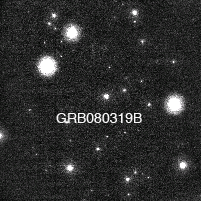Daily Image
15-07-2008I can see for miles and miles!
| Submitter: | Mike Garrett |
| Description: | On the 19th of March 2008, a Gamma Ray Burst (GRB 080319B) was detected that was, in principle, bright enough to be seen by the naked eye for almost 30 seconds! This unprecedented event, assumed to be associated with the collapse of a massive star and the subsequent formation of a black hole, released an intense burst of prompt emission at gamma, x-ray and optical wavelengths, and launched two opposing jets that created a bright afterglow, as the jets ploughed into the surounding stellar environment at close to the speed-of-light. By coincidence, GRB 080319B was located close (on the sky) to an earlier GRB explosion (GRB080319A) permitting several space and ground based telescopes to observe the GRB at the very moment of collapse (including the "Pi of the sky" optical transient telescope). Alexander van der Horst (NASA/NSSTC and formerly Amsterdam) also detected the GRB080319B afterglow at radio wavelengths using the WSRT a few days after the burst. GRB 080319B's optical afterglow was 2.5 million times more luminous than the most luminous supernova ever recorded, making it the most intrinsically bright object ever observed by humans in the universe.It is thought that the afterglow was particularly bright because our line of sight towards the GRB was looking precisely down the centre of the jet.Observations by the VLT telescopes in Chile determined the redshift of the object to be close to 1 when the Universe was about 1/2 its current age. Intriguingly, this GRB could have easily been detected out to a redshift of 16 (well into the epoch of reionisation and the creation of the first massive stars). All the observations (including the WSRT radio results) will be published in an upcoming letter in Nature (Judith Racusin et al.2008). Watch out for further news of the Astron/JIVE daily image. PS GRB 080319B was one of five(yes five!) GRB events that took place within 24 hours of the death of the famous British science fiction writer, Arthur C. Clarke. This apparent "cosmic salute" to Clarke has led some to refer to 080319B as the "Clarke event". |
| Copyright: | Pi of the Sky Telescope (http://grb.fuw.edu.pl/index.html) |
| Tweet |  |
